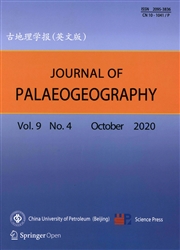Marine transgression(s) to evaporite basin:The case of middle Miocene (Badenian) gypsum in the Central Paratethys, SE Poland
作者:Danuta Peryt,Przemyslaw Gedl,Tadeusz Marek Peryt
摘要:The middle Miocene Badenian evaporite basin of the Carpathian Foredeep Basin was a saline lake, separated by a barrier from the sea and supplied with seawater seeping through the barrier or overflowing it occasionally in the form of short-lived marine transgressions. Such transgressions could leave behind marine microfossils in marly clay intercalations. One of them(2.3 m thick) occurs in the uppermost part of the sulphate sequence, in the unit ‘o’, in the Babczyn 2 borehole section. It contains marine palynomorphs(dinoflagellate cysts) and foraminiferal assemblages indicating a marine environment. The low-diversity benthic foraminiferal assemblages are dominated by opportunistic, shallow infaunally living species, preferring muddy or clayey substrate for thriving, brackish to normal marine salinity, and inner shelf environment. Dinoflagellate cyst assemblages, although taxonomically impoverished, consist of marine species;euryhaline forms that tolerate increased salinity are missing. Relatively common microfossils found in clay intercalations within gypsum have important palaeogeographical implications:they strongly suggest that there existed an additional inflow channel supplying the Polish Carpathian Basin from the south during the evaporite deposition and afterwards.
发文机构:Institute of Paleobiology institute of Geological Sciences Polish Geological Institute-National Research Institute
关键词:EvaporitebasinsTRANSGRESSIONMICROFOSSILSBADENIANPALAEOGEOGRAPHYParatethys
分类号: P73[天文地球—海洋科学]
- Genus Pronephrium Presl 1851 (Thelypteridaceae) in Romania
- Ancient rip current records and their implications: an example from the Cretaceous Ukra Member, Kutch, India
- New freshwater plesiosaurian materials from the Middle Jurassic Xintiangou Formation of the Sichuan Basin, southwestern China
- First steps in reconstructing Early Jurassic sea water temperatures in the Andean Basin of northern Chile based on stable isotope analyses of oyster and brachiopod shells
- A facies and palaeogeography-based approach for analysis of petroleum systems in United Arab Emirates
- The complexity of climate reconstructions using the coexistence approach on Qinghai-Tibetan Plateau
- The use of mineral interfaces in sand-sized volcanic rock fragments to infer mechanical durability
- Fruits of Scirpus (Cyperaceae) from the early Miocene of Weichang,Hebei Province, North China and their palaeoecological and palaeobiogeographical implications
- Words of the Editor-in-Chief——some ideas about the comments and discussions of hyperpycnal flows and hyperpycnites
- Summary of Editorial Committee Meeting (January 5, 2020) of Journal of Palaeogeography


